Introduction
A Land Acquisition Fund serves as a crucial financial resource designated for purchasing or leasing land necessary for development projects. These funds are pivotal for public agencies, private developers, and non-profit organizations, streamlining the land acquisition process. By establishing a dedicated pool of capital, these funds enhance project efficiency and ensure prompt response to land-related needs.
They cover various costs associated with land acquisition, including purchase prices, legal fees, and other related expenses.
The importance of such funds is exemplified by India's National Solar Mission, launched in 2010, which aimed to establish the country as a global leader in solar energy. Access to vast tracts of land was a significant hurdle, but with the support of dedicated financial resources, India achieved 99.6% electricity access by 2021. This success story underscores the necessity of Land Acquisition Funds in overcoming barriers to large-scale infrastructure projects, particularly in the realm of climate-smart development.
Globally, the challenge of securing land for renewable energy projects is mirrored in many developing countries, where climate adaptation costs could reach $390 billion this decade. Public funds alone cannot bridge this gap, highlighting the need for significant private financing. Effective land acquisition systems empower both governments and the private sector to invest in renewable energy, transit-oriented development, and broader infrastructure projects, ultimately contributing to climate resilience and sustainable development.
What is a Land Acquisition Fund?
A Land Acquisition Fund acts as an essential financial resource allocated for acquiring or renting property needed for development initiatives. These resources are essential for public agencies, private developers, and non-profit organizations, simplifying the property procurement process. By establishing a dedicated pool of capital, these funds enhance project efficiency and ensure prompt response to land-related needs. They cover various costs associated with property acquisition, including purchase prices, legal fees, and other related expenses.
The importance of such funds is exemplified by India's National Solar Mission, launched in 2010, which aimed to establish the country as a global leader in solar energy. 'Access to vast tracts of territory was a significant hurdle, but with the support of dedicated financial resources, India achieved 99.6% electricity access by 2021.'. 'This success narrative highlights the importance of Land Acquisition Funds in overcoming obstacles to large-scale infrastructure initiatives, particularly in the area of climate-smart progress.'.
Worldwide, the challenge of obtaining space for renewable energy initiatives is reflected in numerous developing nations, where expenses for climate adaptation could hit $390 billion this decade. Public funds alone cannot bridge this gap, highlighting the need for significant private financing. Efficient land procurement frameworks enable both authorities and the private sector to invest in renewable energy, transit-oriented growth, and larger infrastructure initiatives, ultimately aiding in climate resilience and sustainable development.
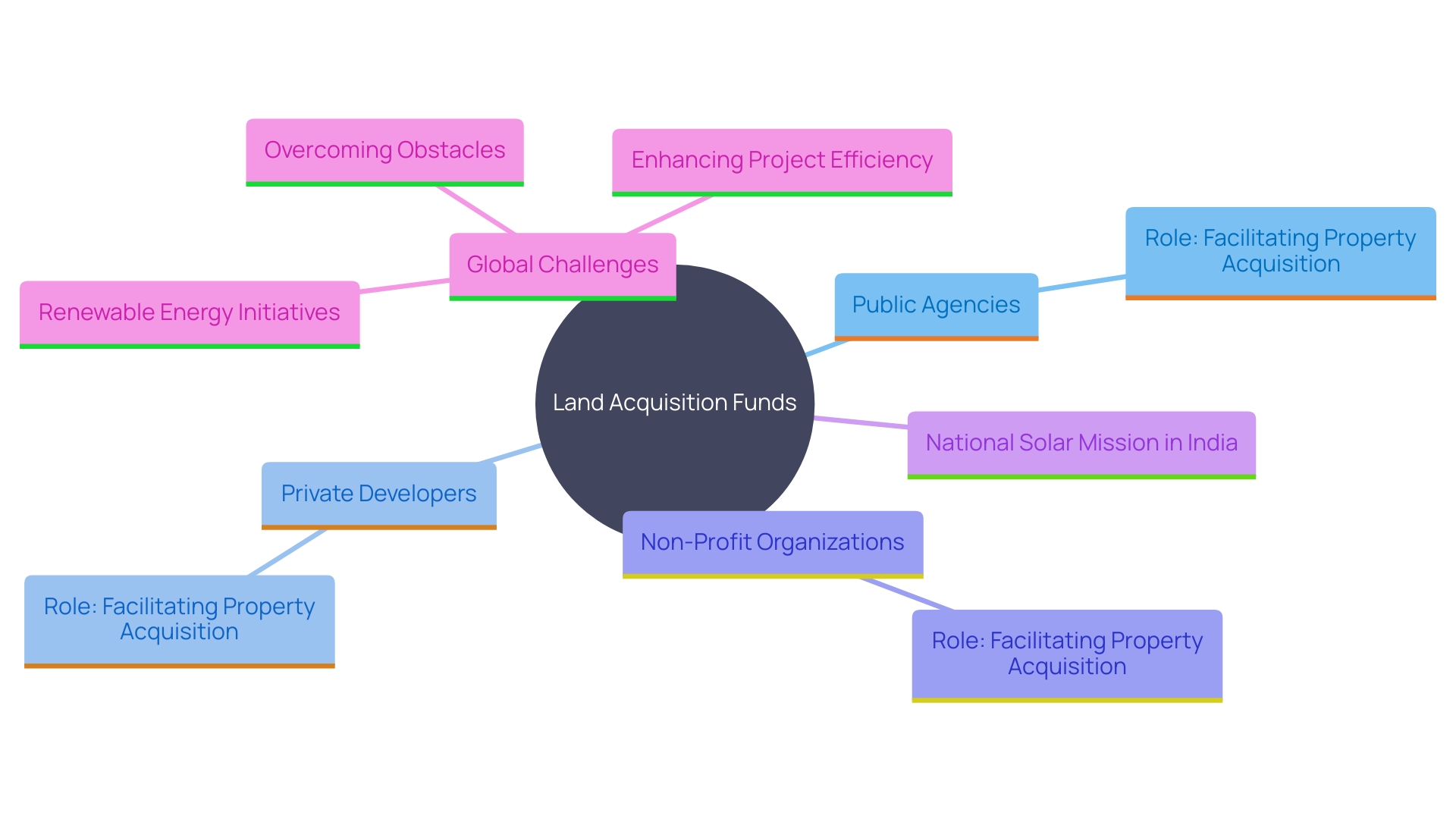
Types of Land Acquisition Financing
Land acquisition financing can be approached through various channels, including public financing, private investment, and grants. Public financing usually includes government resources designated for particular initiatives. For instance, the Bipartisan Infrastructure Law, enacted in 2021, represents a historic investment in America's infrastructure, providing substantial funding to support state and local governments. 'This type of financing is crucial for large-scale initiatives that benefit the public, such as energy resiliency and grid modernization programs in rural areas, which received $1 billion over five years under the ERA program.'.
Private investment, on the other hand, involves funds from developers or investors seeking potential returns. Innovative approaches, such as the use of 'other transaction authority' (OTA) by organizations like OCED, are designed to attract private investment in underinvested markets, including advanced nuclear and long-duration energy storage technologies. This flexibility encourages private sector participation by reducing bureaucratic hurdles.
Funding from foundations or government initiatives also plays a significant role, especially for undertakings with social or environmental benefits. Organizations like the OPEC Fund, which has dedicated around $27 billion to development initiatives in over 125 countries, exemplify how grants can support essential needs such as clean water, sanitation, and healthcare. These grants are crucial for ensuring the successful execution of initiatives that might otherwise struggle to secure funding.
Understanding these diverse financing options is essential for selecting the most appropriate funding mechanism for a Land Acquisition Fund, ensuring that projects can proceed smoothly and achieve their intended benefits.
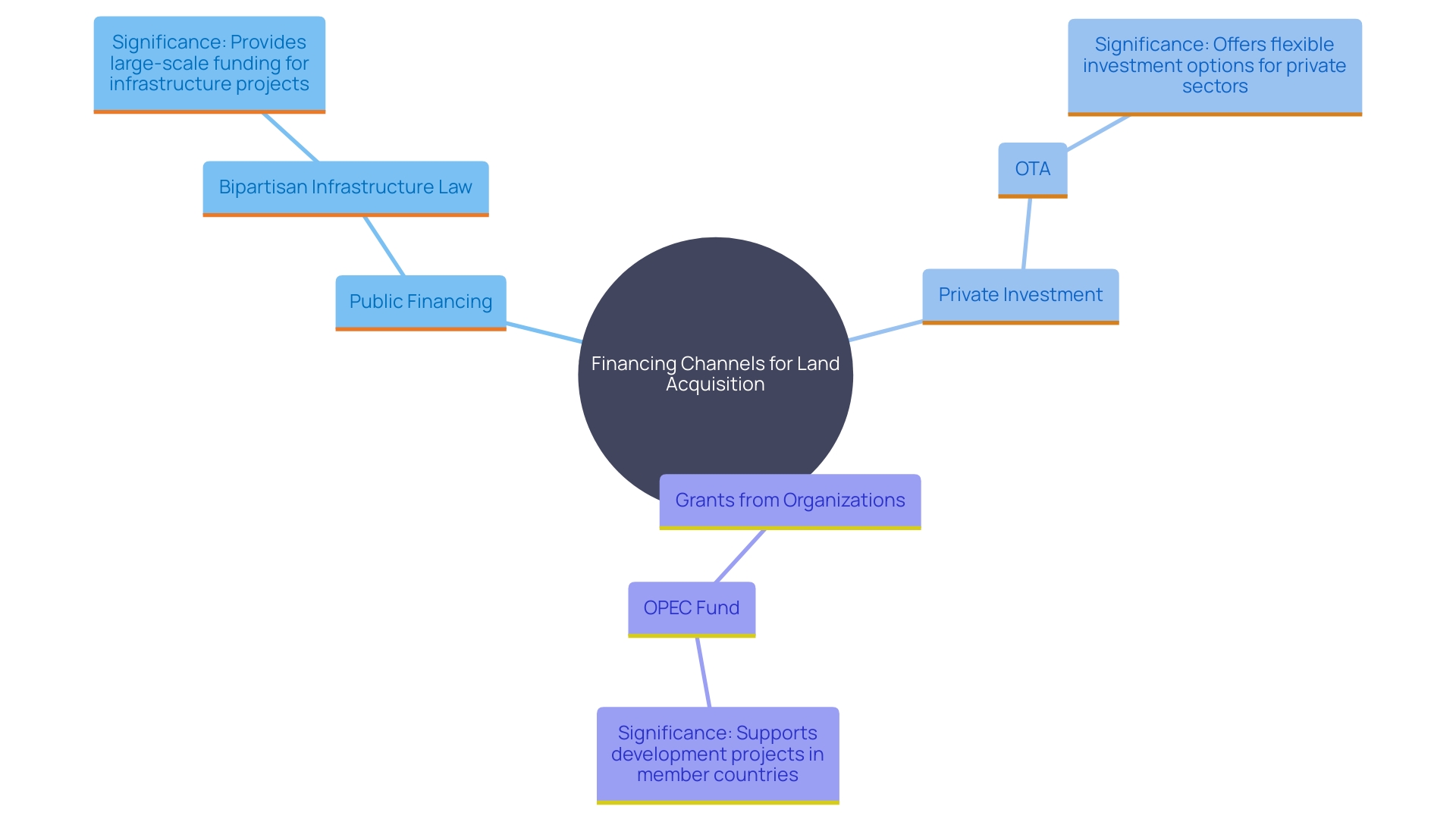
Key Considerations for Land Acquisition
Participating in property acquisition requires careful consideration of several essential factors. A comprehensive grasp of local zoning laws, environmental regulations, and property use policies is essential. For instance, zoning ordinances can significantly influence the implementation of infrastructure initiatives, as seen in the Great Lakes Region's rural utility-scale solar deployment. Evaluating the market worth of property guarantees just remuneration, a fundamental aspect of ethical procurement practices.
Stakeholder engagement is vital for addressing community concerns and aligning with public interests. Effective use of open data can bolster this process by providing transparency and empowering vulnerable groups, as demonstrated by initiatives involving the First Nations in Canada. Furthermore, managing timelines and budget constraints is crucial to maintaining momentum and avoiding costly delays. The 2024 Trend Report emphasizes the urgency for planners to act now, prepare, learn, and watch for emerging trends that could impact their work and the communities they serve. By integrating AI and other technologies, planners can enhance decision-making, predict urban growth patterns, and optimize resource allocation, ultimately leading to more sustainable and livable cities.
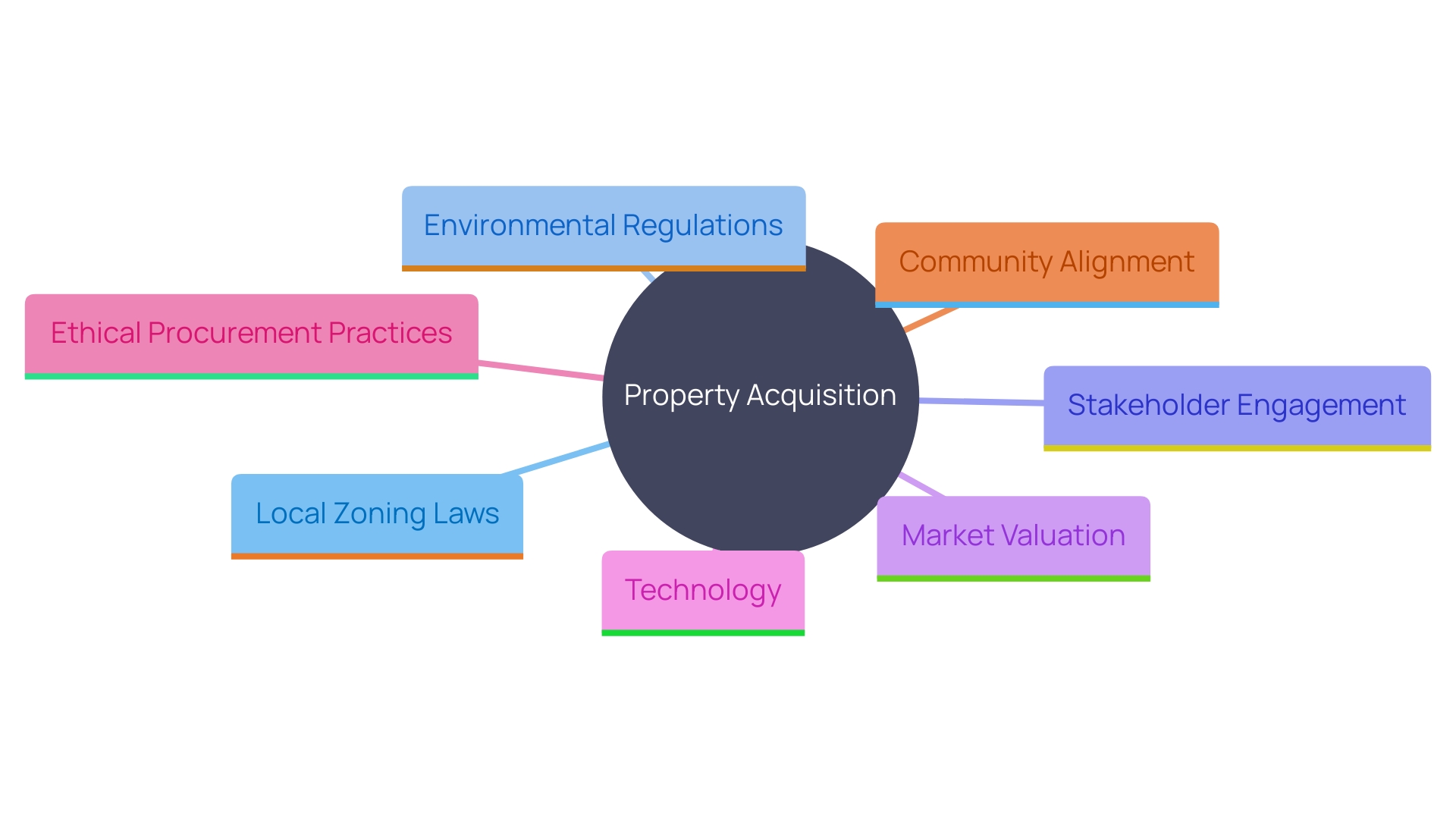
Benefits of Using a Land Acquisition Fund
Employing a Property Purchase Fund provides various benefits, greatly improving the efficiency and effectiveness of property procurement procedures. Dedicated funding expedites transactions, facilitating swifter project initiation and development. This is particularly crucial in rapidly urbanizing regions like India, which is poised for substantial economic growth and green structural transformation. As stated by the Intergovernmental Panel on Climate Change, climate change is closely related to territory usage and governance, emphasizing the significance of effective property procurement methods.
A structured approach to property costs through an acquisition fund not only enhances financial feasibility but also offers a clear framework for budgeting and expenditure. 'This is crucial for extensive undertakings that demand significant territory resources, such as renewable energy investments and climate-smart infrastructure.'. The LAND-at-scale program, funded by the Netherlands Ministry of Foreign Affairs, emphasizes the need for efficient land governance to support sustainable progress and reduce conflicts over land.
Furthermore, a Land Acquisition Fund enhances negotiation power with landowners. Demonstrating preparedness and financial commitment can lead to more favorable terms and conditions, thus ensuring smoother transactions. Savvy developers understand the importance of securing favorable agreements to mitigate risks associated with regulatory changes and market volatility. As highlighted by experts, project agreements are crucial tools that can protect initiatives from subsequent zoning changes and other regulatory challenges.
In summary, the strategic implementation of a Land Purchase Fund not only accelerates the purchasing process but also strengthens financial planning and negotiation capabilities, ultimately supporting sustainable development and climate resilience.
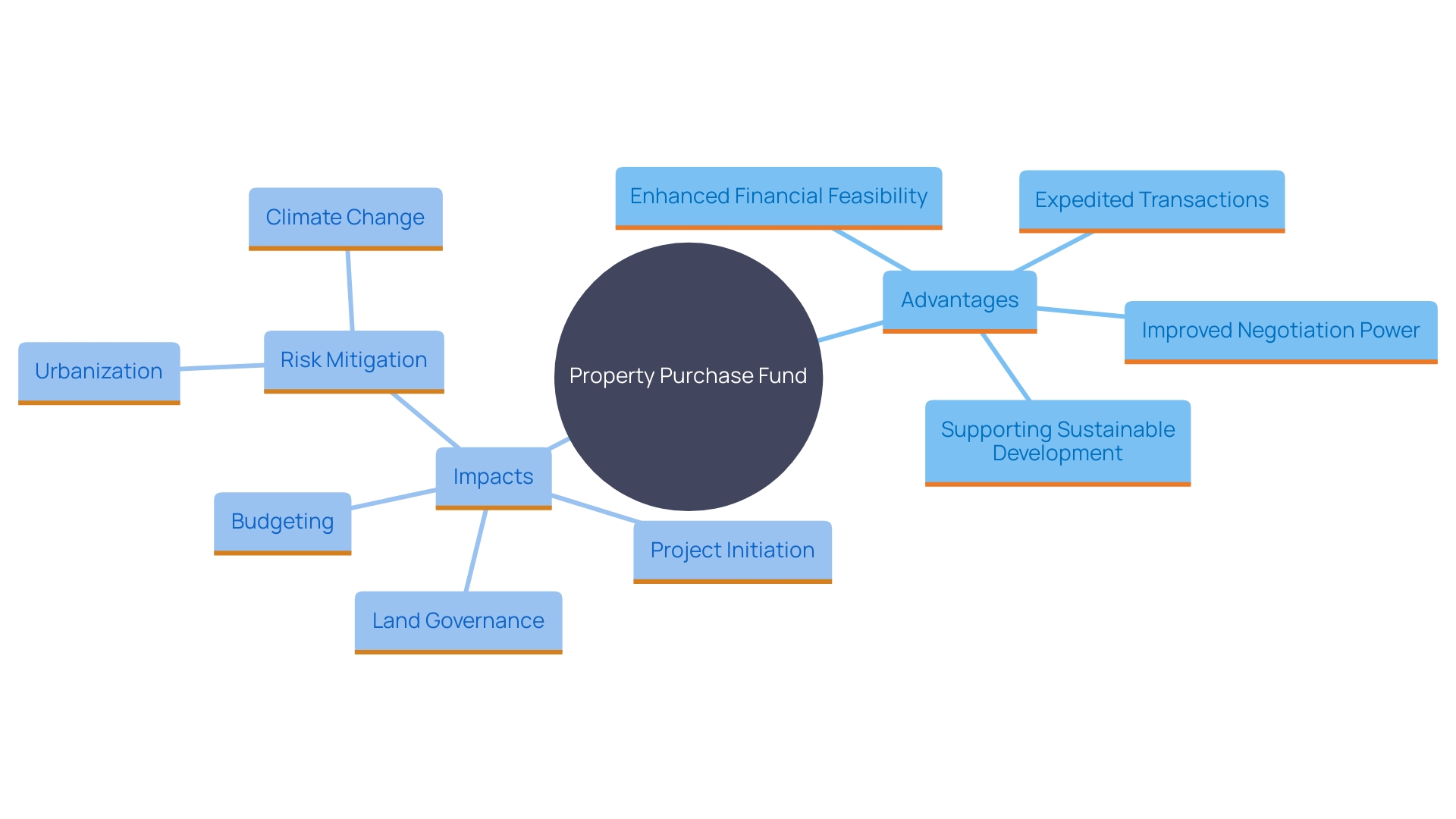
Challenges and Risks in Land Acquisition Funding
Despite the advantages, there are significant challenges and risks associated with property acquisition funding. Fluctuations in real estate markets can dramatically affect property prices, potentially pushing costs beyond the allocated budget. The Real Estate market's dynamic nature, driven by customer preferences for convenience, affordability, and sustainability, adds to the uncertainty. Legal and regulatory hurdles are another major concern. Navigating the complex web of laws and regulations can be daunting, particularly when considering the varying requirements across different jurisdictions. Additionally, stakeholder opposition is a frequent obstacle. Community interests must be carefully managed to avoid conflicts that can hinder initiatives. As Righetti, an expert on U.S. energy law, points out, engaging with local and national agencies is crucial for overcoming these barriers. Effective risk management strategies, such as thorough market analysis and stakeholder engagement, are essential to mitigate these challenges and ensure successful property purchases.
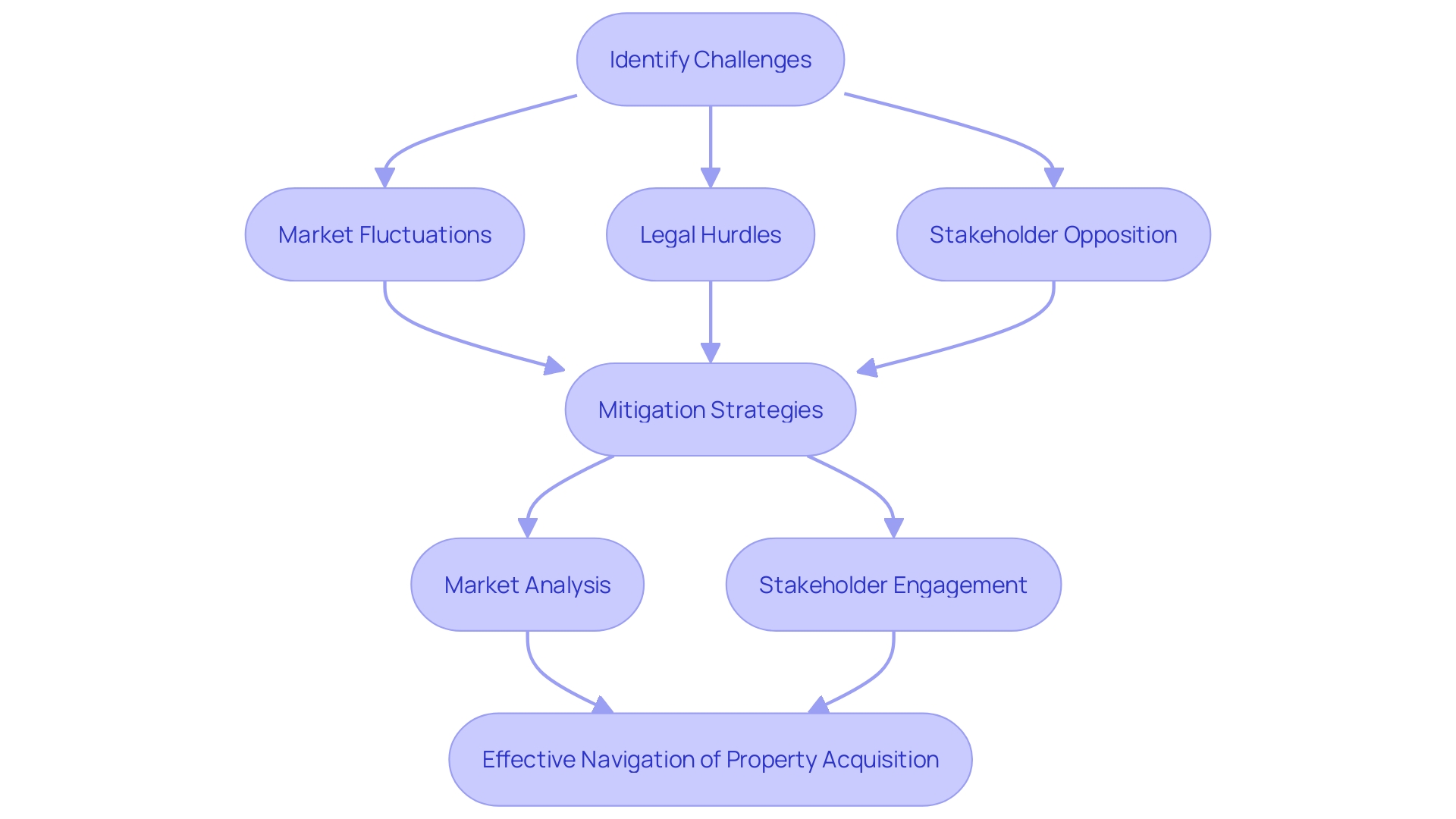
Best Practices for Utilizing Land Acquisition Funds
To maximize the effectiveness of Land Acquisition Funds, the adoption of best practices is essential. Conducting thorough due diligence to evaluate potential properties is a fundamental step. This process ensures that all aspects, including environmental, legal, and logistical factors, are meticulously assessed. Transparent communication with stakeholders is another critical practice, fostering trust and facilitating smoother negotiations. Regularly updating financial plans to reflect market changes is vital to maintaining fiscal responsibility and adaptability in an ever-evolving market.
Creating a clear purchasing plan that matches the objectives of the initiative is essential. This involves setting precise objectives and parameters for property acquisition activities, ensuring that every action taken is in service of the overarching project vision. Utilizing advanced technology significantly enhances decision-making processes. Geographic Information Systems (GIS) mapping and Artificial Intelligence (AI) tools can provide valuable insights and predictive analyses, streamlining the identification of suitable terrain and optimizing fund utilization.
For instance, the integration of AI in environmental assessments has proven transformative. Ai's capacity to examine extensive datasets can speed up the recognition of high-impact chances for sustainable resource management. This technological integration not only improves efficiency but also supports the broader goals of addressing climate change and promoting environmental sustainability. Ultimately, by leveraging these best practices and technological advancements, land acquisition processes can be more effective, strategic, and aligned with long-term development objectives.
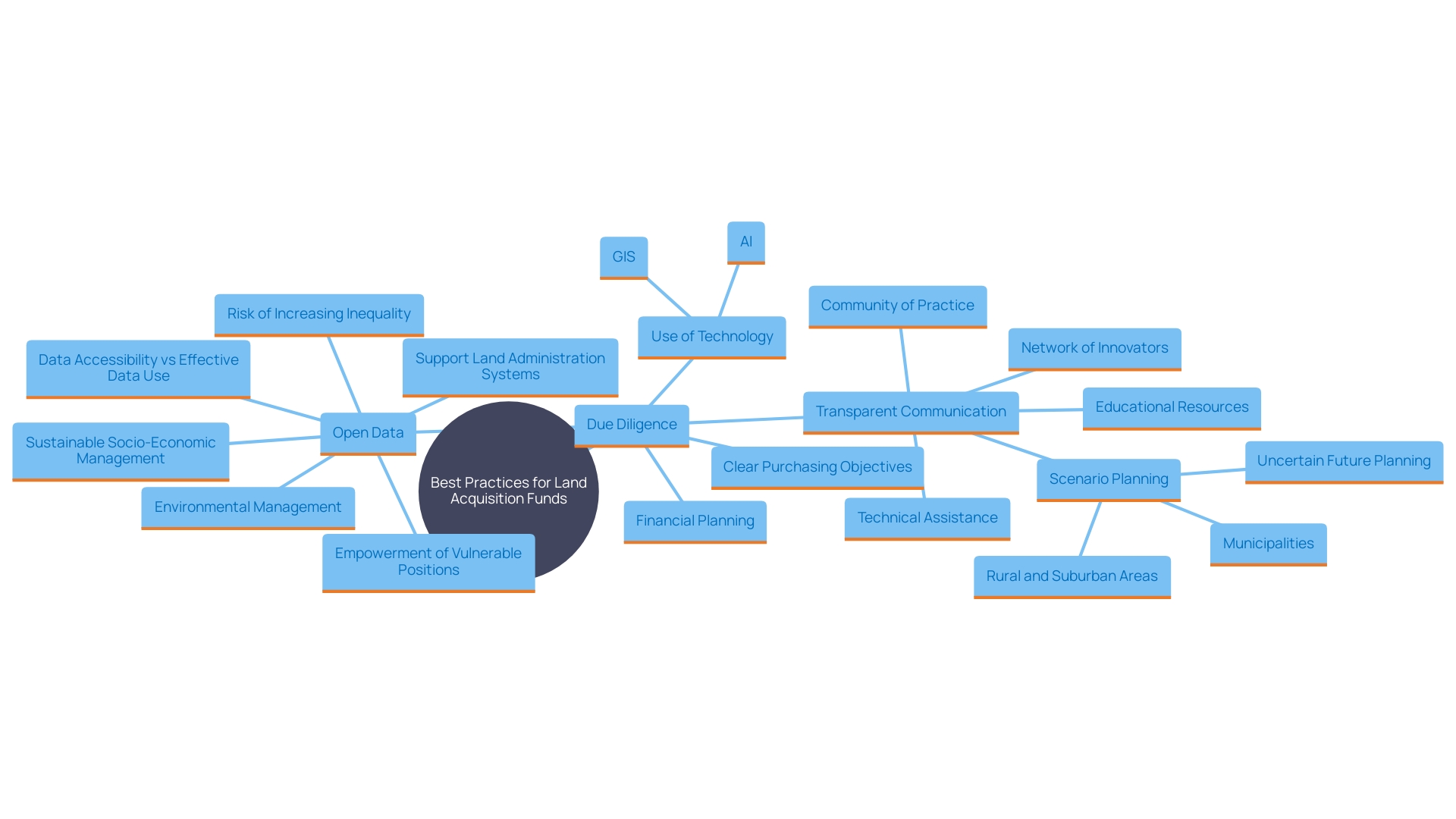
Conclusion
The significance of Land Acquisition Funds in facilitating development projects cannot be overstated. These funds serve as essential financial instruments that streamline the acquisition process, ensuring that public agencies, private developers, and non-profit organizations can respond swiftly to land-related needs. By covering various costs associated with land acquisition, these funds enhance project efficiency and support large-scale initiatives, particularly in climate-smart development.
The diverse financing options available, including public financing, private investment, and grants, highlight the multifaceted nature of land acquisition funding. Each approach offers unique advantages, enabling stakeholders to select the most appropriate mechanism for their specific projects. Engaging with local communities and understanding regulatory frameworks is crucial for successful land acquisition, as is the ability to navigate the challenges posed by fluctuating market conditions and stakeholder opposition.
Utilizing a Land Acquisition Fund not only accelerates project timelines but also strengthens negotiation capabilities and financial planning. The adoption of best practices, such as thorough due diligence, transparent communication, and the integration of advanced technologies like AI, further enhances the effectiveness of these funds. By embracing these strategies, stakeholders can overcome obstacles and contribute to sustainable development and climate resilience.
The strategic implementation of Land Acquisition Funds thus emerges as a vital component in achieving long-term infrastructure goals while addressing the pressing challenges of climate change.




